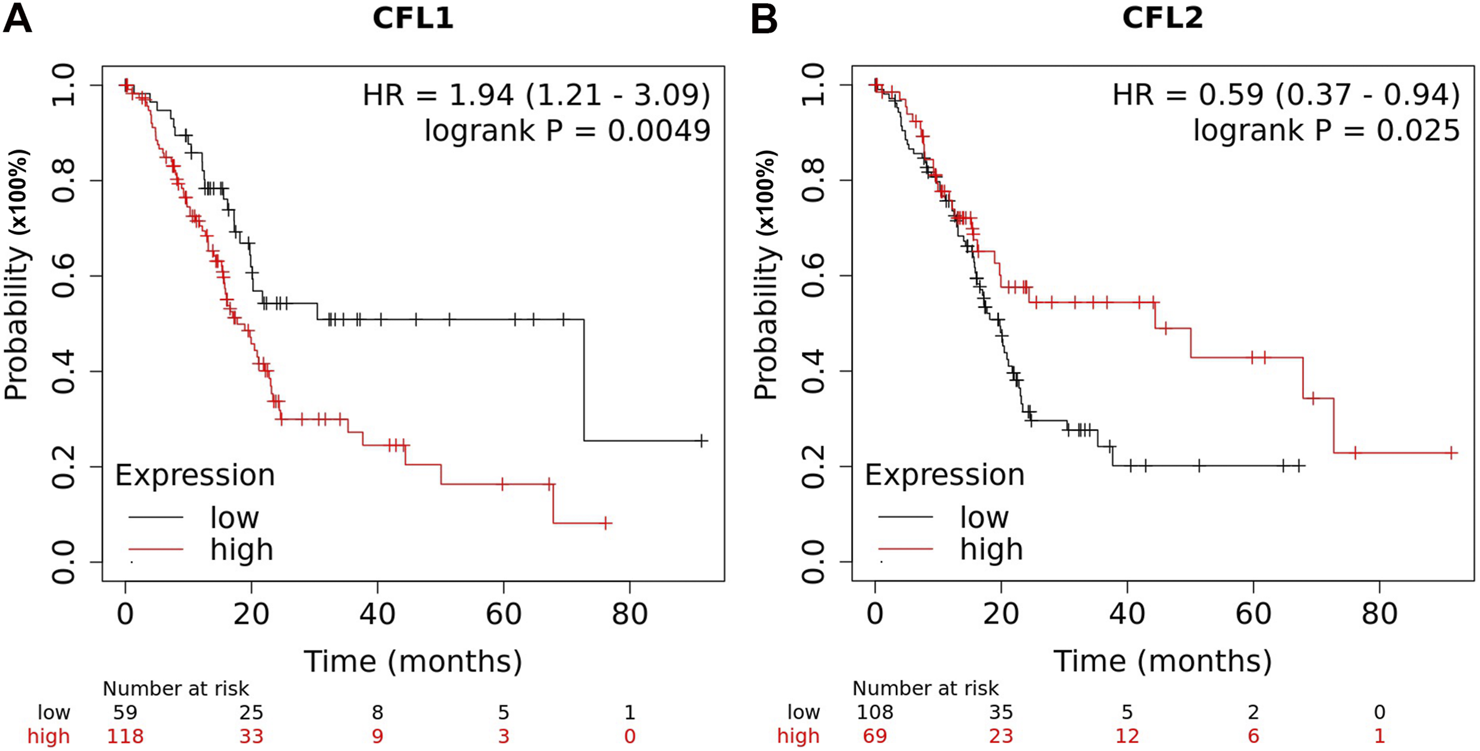To the Editor,
Proteomics is a technique for analyzing protein expression at the cellular level. Proteomic technology that combines two-dimensional gel electrophoresis (2-DE) and liquid chromatography-tandem mass spectrometry (LC-MS/MS) has a high throughput and accuracy [1]. This technique is useful for comprehensively analyzing human disease proteomes and has been widely applied to detect biomarkers and molecular targets in different cancers. We previously performed differential display analysis by using 2-DE and LC-MS/MS between pancreatic cancerous and adjacent non-cancerous tissue samples [2]. One of the numerous spots that showed stronger intensity in cancerous than non-cancerous tissues was identified as non-muscle cofilin (cofilin-1). We further validated the expression of cofilin-1 by Western blot analysis. We found that cancerous tissues showed significantly higher levels of cofilin-1 than non-cancerous tissues. Meanwhile, muscle cofilin (cofilin-2), an isoform of cofilin, has also been examined in pancreatic cancerous tissue samples. Intriguingly, we observed that cancerous tissues exhibited significantly lower levels of cofilin-2 than non-cancerous tissue samples. This was the first time that cofilin isoforms were differentially expressed in pancreatic cancerous tissues, implying that they could be involved clinicopathologically in patients with PDAC. Therefore, an online bioinformatics tool (https://kmplot.com/analysis/) has been used to clarify the prognostic significance of cofilin isoforms in PDAC [3]. Using the Kaplan-Meier survival plot, we found a high level of cofilin-1 expression is inversely linked to patient survival. In contrast, high cofilin-2 is positively associated with prolonged patient survival (Figure 1). It is worth mentioning that the results of Kaplan-Meier survival plots were similar to our previous data, which showed that cofilin-1 and cofilin-2 were opposingly expressed in pancreatic cancer tissues. These observations incite interest in cofilin and focus on the relationship between their isoforms and PDAC progression. Together our previous report and the current analysis imply that cofilin isoforms may represent novel potential prognostic biomarkers in patients with PDAC. Further studies are warranted to explore the underlying mechanisms by which cofilin isoforms are involved in patients with PDAC.
FIGURE 1

Kapan-Meier survival analysis of cofilin-1 and cofilin-2 expression in pancreatic ductal adenocarcinoma. (A) The survival analysis of CFL1 (cofilin-1) was performed by using the Kaplan-Meier Plotter platform. The survival plot compared a high-risk group (in red) and a low-risk group (in black) in PDAC tissues. (B) The survival analysis of CFL2 (cofilin-2) was performed by using the Kaplan-Meier Plotter platform. The survival plot compared a high-risk group (in red) and a low-risk group (in black) in PDAC tissues. p < 0.05 were regarded as statistically significant.
Statements
Author contributions
All authors contributed to the study’s conception and design. Data collection and analysis were performed by SI, TK, and YK. SI wrote the first draft of the manuscript, TK and YK commented on previous versions of the manuscript. All authors read and approved the final manuscript.
Conflict of interest
The authors declare that the research was conducted in the absence of any commercial or financial relationships that could be construed as a potential conflict of interest.
References
1.
Lippolis R De Angelis M . Proteomics and Human Diseases. J Proteomics Bioinform (2016) 09:3. 10.4172/jpb.1000391
2.
Wang Y Kuramitsu Y Ueno T Suzuki N Yoshino S Iizuka N et al Differential Expression of Up-Regulated Cofilin-1 and Down-Regulated Cofilin-2 Characteristic of Pancreatic Cancer Tissues. Oncol Rep (2011) 26:1595–9. 10.3892/or.2011.1447
3.
Nagy Á Munkácsy G Györffy B . Pancancer Survival Analysis of Cancer Hallmark Genes. Sci Rep (2021) 11:6047. 10.1038/s41598-021-84787-5
Summary
Keywords
biomarker, pancreatic ductal adenocarcinoma, cofilin, proteomics, kaplan-meier
Citation
Islam S, Kitagawa T and Kuramitsu Y (2021) Prognostic Significance of Cofilin Isoforms in Patients With Pancreatic Ductal Adenocarcinoma. Pathol. Oncol. Res. 27:1609821. doi: 10.3389/pore.2021.1609821
Received
28 March 2021
Accepted
07 April 2021
Published
10 May 2021
Volume
27 - 2021
Edited by
József Tímár, Semmelweis University, Hungary
Updates
Copyright
© 2021 Islam, Kitagawa and Kuramitsu.
This is an open-access article distributed under the terms of the Creative Commons Attribution License (CC BY). The use, distribution or reproduction in other forums is permitted, provided the original author(s) and the copyright owner(s) are credited and that the original publication in this journal is cited, in accordance with accepted academic practice. No use, distribution or reproduction is permitted which does not comply with these terms.
*Correspondence: Yasuhiro Kuramitsu, climates@hoku-iryo-u.ac.jp
Disclaimer
All claims expressed in this article are solely those of the authors and do not necessarily represent those of their affiliated organizations, or those of the publisher, the editors and the reviewers. Any product that may be evaluated in this article or claim that may be made by its manufacturer is not guaranteed or endorsed by the publisher.